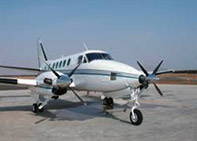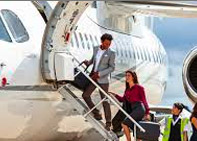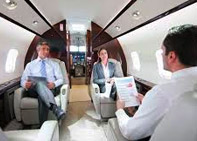Learn to Fly
Become a PilotThe first steps to becoming a pilot is firstly you need to decide
what you want to fly. The rules for getting a pilots license are
different depending on the type of aircraft you want to fly. You
can choose between, gliders, balloons, gyroplanes, helicopters,
airplanes and airships, but if you just want to fly an ultralight
vehicle, then you will not need a pilots license.
There are many different types of pilot's license, from student
pilot to airline transport pilot, but deciding which test you
want to do is up to you.
First Time Flyers should consider 'Virtual Lessons' to make themselves
familiar with the cockpit. If possible visit your local Cirrus
Training
Center that introduce general aviation. Instructors are internally
trained
to Cirrus Standardized Instructor Pilots (CSIP) standards so they
are
throughly familiar with your aircraft and understand the importance
of
transition training.
This will make your first real test flight much easier allowing
you to
master the art of flying in a shorter time period.
Performance Based Navigation
The benefits of performance based navigational capability are safety, access, capacity, predictability, efficiency and environmental impacts. Current airspace design and utilization are a result of several contributing factors, including the location of ground based NAVAIDS and conventional navigation methods, i.e. navigating from one very high frequency (VHF) omni directional range (VOR) to another. These conventional navigation methods lead to less efficient routes, procedures and airspace. Inefficiency also is driven by large airspace separation buffers that are required to mitigate the operational risks due to inaccuracies associated with conventional navigation methods.
Once operators and controllers are fully equipped and sufficiently trained for performance based navigation, the FAA will redesign airspace to increase capacity and improve operational efficiencies. With automation and other infrastructure improvements, such as automatic dependant surveillance broadcast (ADS-B) and tools that permit controllers to optimize new airspace design through improved sequencing and traffic management, we expect synergistic benefits to accrue.
Performance based navigation benefits apply to airspace operators and service providers alike. Performance based navigation will:
- Increase safety through continuous descent procedures that reduce the risk of controlled flight into terrain (CFIT) and loss of control. Predefined RNAV and RNP procedures enhance confidence and consistency and reduce the risk of communication errors.
- Improve airport and airspace access I all weather conditions and the ability to meet environmental and obstacle clearance constraints through the application of optimized RNAV based flight tracks. The result will be reduced lateral separation criteria and more accurate path keeping.
- Enhance reliability, repeatability and predictability of operations, leading to increased throughput. More precise arrival, approach and departure procedures will reduce dispersion and facilitate smoother traffic flows.
- Increase schedule reliability through more consistent access and throughput in all weather conditions.
- Reduce delays at airports and in certain dense airspace through the application of new parallel routes, newly enabled ingress/egress points around busy terminal areas, improved flight re-routing capabilities, making better use of closely spaced procedures and airspace, and de-conflicting adjacent airport flows.
- Increase efficiency through less circuitous routes and optimized airspace, especially in lower flight altitude stratums.
- Enable flexible routes such as wind optimal and great circle routes when beneficial.
- Promote design and use of environmentally beneficial arrival and departure procedures that allow the aircraft system (FMS) to manage flight performance (climb, descent, engine performance, etc..) Benefits include reduced fuel emissions and environmentally tailored noise footprints.
Moving forward with a performance based navigation strategy offers a variety of opportunities to realize benefits for the user community. Many of these benefits can and must be realized in the near term, leveraging sufficient levels of aircraft and automation capabilities in certain airspace.
First FlightCertified Flyers








